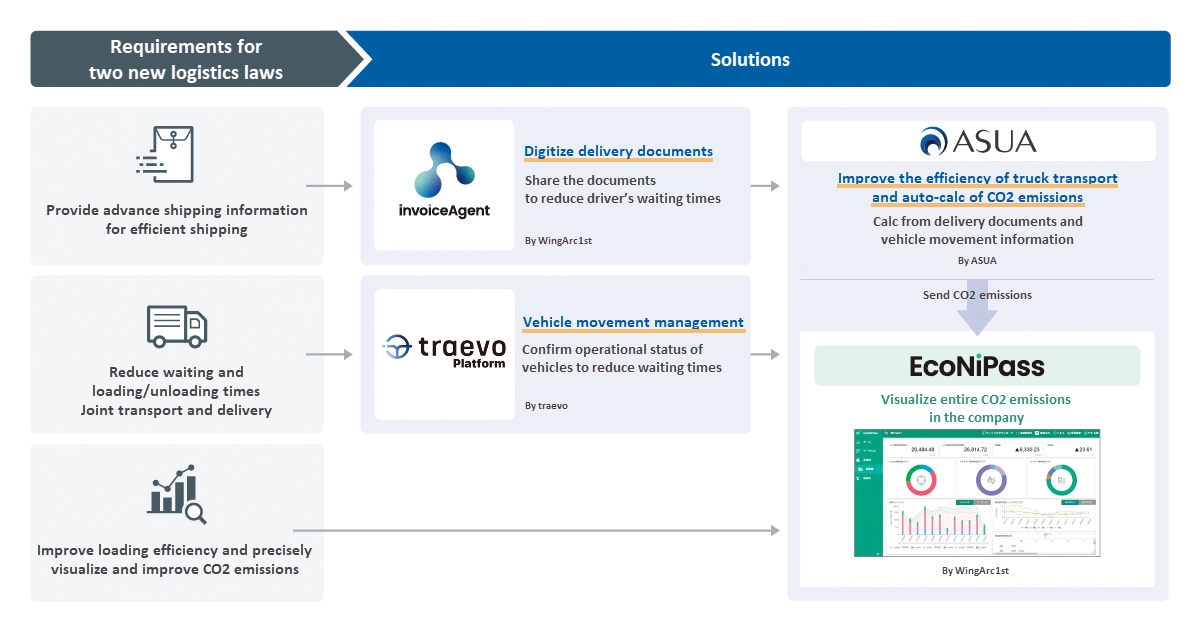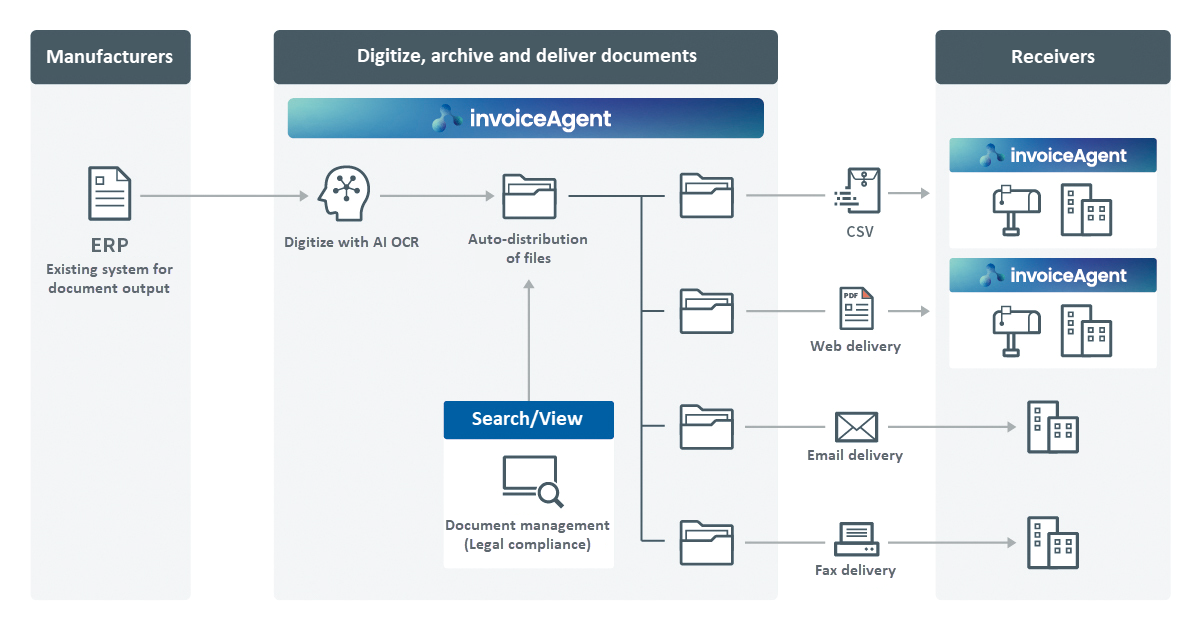WingArc1st, ASUA and traevo collaborate to support shippers and transport companies in complying with new laws to improve the efficiency of goods distribution
- Accelerate compliance with new legislation -
WingArc1st Inc.
ASUA Inc.
traevo
Two new logistics laws are scheduled to go into effect on 1 April 2025. WingArc1st Inc., ASUA Inc. and traevo will begin collaborating from 13 February to build a system that will provide comprehensive support for achieving compliance with the new Logistics Efficiency Act. The system will help reduce waiting and loading/unloading times, provide advance shipping information, improve loading efficiency, and reduce CO2 emissions.

■Background
There are additional requirements defined in the new laws:
1. Provision of advance shipping information to improve the efficiency of loading and unloading operations
The three-ministry joint conference promoting the Logistics Efficiency Act stipulates that companies should provide advance shipping information to reduce truck drivers' loading and unloading time.
WingArc has been working with government agencies and shippers to digitize the relevant documents (*1). By utilizing invoiceAgent, WingArc's electronic document platform, it is possible to digitize the system for printing existing paper documents without making changes to the host system. This means invoice information can be provided to the recipient in advance in PDF or any other digital format. The documents comply with the logistics information standard guidelines (*2), making it possible to smoothly exchange and utilize invoice data even between different services.

The Logistics Efficiency Act requires that cargo information be notified to suppliers in advance in order to improve the efficiency of goods inspections. The earlier the shipping documents are converted to electronic forms, the earlier that information can be shared.
(*1) Transport and Tourism Action Plan for Standardizing Logistics in the Processed Food Sector by Ministry of Land, Infrastructure
The 3rd follow-up meeting, the "Delivery Slip Ecosystem"
https://www.mlit.go.jp/seisakutokatsu/freight/content/001706138.pdf (Japanese)
(*2) Compliance with JPIC Logistics Information Standard Guidelines
https://www.lisc.or.jp/case/3112/ (Japanese)
2. Understanding and improving waiting times/loading and unloading times, and conducting joint transport
The Logistics Efficiency Act requires shippers and transport companies to reduce waiting times and loading and unloading times.
In addition, the three-ministry joint meeting requires that shippers should properly understand the situation regarding waiting times/loading and unloading times and the effects of initiatives. Understanding the situation and its effects should be done efficiently through the use of digital technology.
Traevo's vehicle movement management platform, the traevo Platform, allows companies to consolidate and centrally manage vehicle movement information obtained from existing network-based digital tachographs and other devices, as well as business records such as waiting for cargo and loading and unloading work, for not only their own vehicles but also those of their partners. By granting authority, information can be shared with the prime contractor and shipper. In addition, traevo is using its accumulated operation data to conduct a demonstration experiment of joint transportation matching with local governments (*3). Traevo supports the following task which is one of the shippers' requirements:
Shippers should ensure appropriate lead times and promote joint transformation with other organizations so that truck operators can proactively combine cargo from multiple shippers and engage in joint deliveries.
(*3) Construction of a digital matching system for joint transport led by shippers.
https://prtimes.jp/main/html/rd/p/000000046.000032158.html (Japanese)
A joint transport digital matching business in Hokkaido to solve the Logistics 2024 Problem
https://traevo.jp/topics/press/20250129 (Japanese)
3. Improving loading efficiency and precisely visualizing and improving CO2 emissions
Shippers and transport companies are asked to improve loading efficiency and understand and make improvements to CO2 emissions (*4).
ASUA is a member of the "Project to Reduce CO2 Emissions by Improving Load Capacity" (*5) and working with Transportation Digital Business Conference (TDBC) as well. It promotes demonstration experiments to improve logistics through visualization of CO2 emissions and achieve carbon neutrality (*6)
ASUA plans to provide a mechanism for automatically calculating loading efficiency and CO2 emissions using advance shipping information. This will improve efficiency through the digitization of documents using invoiceAgent, combined with travel distance data from the traevo Platform.
CO2 emissions in logistics can be understood by linking with WingArc's CO2 emissions visualization platform, EcoNiPass, which provides information on other companies' Scope 3 (*7) E3 emissions related to your own business activities.
(*4) "In light of the burden on the environment caused by carbon dioxide emissions and other factors in the logistics process, there is a demand to contribute to the realization of a carbon-free society through measures such as improving the efficiency of truck transport, joint transport and delivery, and promoting modal shifts in order to reduce that burden."
(*5) Notice regarding the "Project to reduce CO2 emissions by improving loading capacity" with Toyota Mobility Parts Corporation
https://ssl4.eir-parts.net/doc/246A/tdnet/2528003/00.pdf (Japanese)
(*6)TDBC Forum 2024(WG05)
https://tdbc.or.jp/docs/forums/2024/wg05b.pdf (Japanese)
In order to achieve carbon neutrality by 2050, companies are stepping up efforts to reduce CO2 emissions throughout their supply chains. In particular, EU battery regulations have made it mandatory to calculate carbon footprints (CFP), and various industry associations are currently considering calculation rules. When calculating CFP, it is necessary to accurately calculate the CO2 emissions during transportation per product.
Under the supervision of TDBC and Asua, "EcoNiPass" will provide a function to calculate the CO2 emissions from the transportation of each product (scheduled for release in summer 2025). This new capability will enable more precise CFP calculations, by using actual data for transportation, in addition to the existing calculation that is derived from manufacturing data. In addition to providing precise CFP calculations, by linking "invoiceAgent" and "traevo Platform" with ASUA, CFP calculations can be automated, enabling companies to significantly reduce the amount of time and effort that is currently required for CFP calculations.
Contact on Products and Services:
WingArc1st Inc.
Roppongi Grand Tower, 3-2-1 Roppongi, Minato-ku, Tokyo106-0032, Japan
TEL : 81-3-5962-7300
FAX : 81-3-5962-7301
E-mail :
*Company names and product names enlisted in this Press Release are trademarks or registered trademarks of each company.